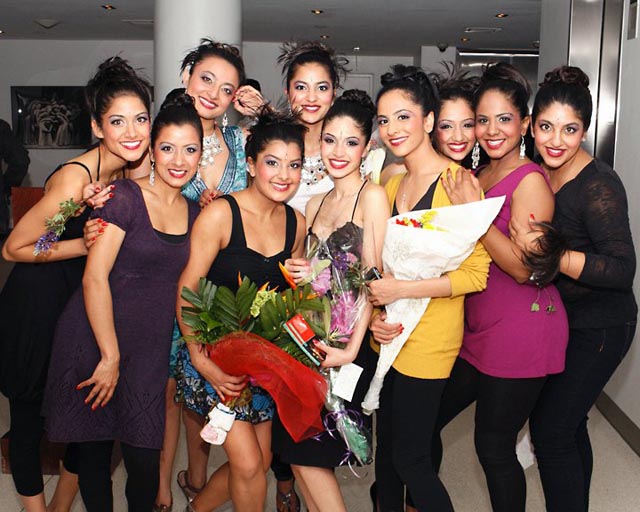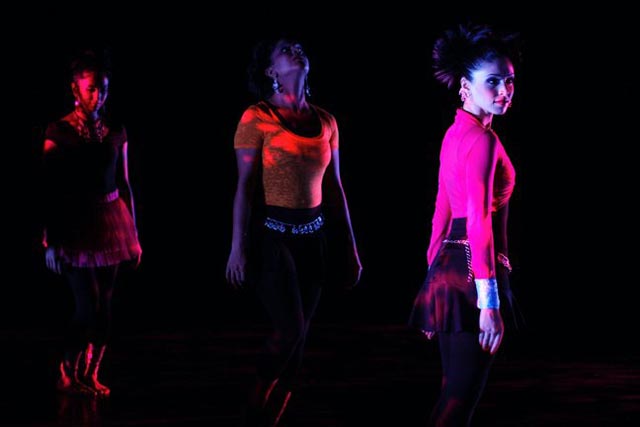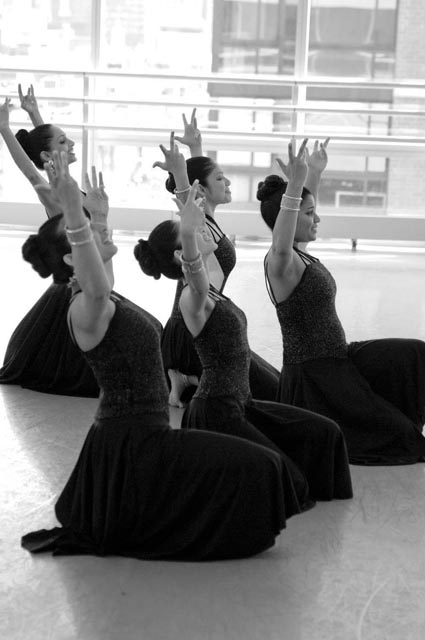
Payal Kadakia and the Sa Dancers bridge India and America
They are probably some of the brainiest dancers in America, having graduated from top universities like Stanford to MIT to Harvard Business School. Indeed, between them, the sprightly Sa Dancers have degrees in everything from mechanical engineering to computer science – but they sure can dance!
Last year when they performed at the Indo-American Arts Council’s Downtown Dance Festival, Alastair Macaulay of The New York Times was quite taken by their “combined stamina, skill and wonderful glee” and wrote that they “danced with irresistible good humor and high energy.”
The director Mira Nair loves their work so much that she says, “I’m in the middle of bringing my beloved film ‘Monsoon Wedding’ to Broadway as a big fat musical – and all these dancers have a real quick job waiting for them!”
The Sa Dance Company, founded by Artistic Director Payal Kadakia, and developed with Associate Artistic Director Drasti Panchal, had its first major solo showing at the prestigious Ailey Citigroup Theater this past month, and it played for three sold out shows to 800 people.
Mira Nair made an interesting observation about the Sa girls, who were in radiant Indian costumes at this event, a la Bollywood, which made her affectionately refer to them as the ‘Madhuri Dixit chicks.’
“The first time I saw them perform they were in black leotards and white tee-shirts and that was quite a revolution because I had never seen that with an Indian dance company,” she says. “I was also quite intrigued that the women came in all shapes and sizes which made me feel very good.”

Indeed, the women have chutzpah – they blend east and west, mixing antique silver bangles with long gowns, Hip Hop with Kathak, Bollywood with contemporary American dance. They celebrate their differences and their similarities and share them on the stage with the audience.
So who are the Sa Dancers? What makes them dance with high energy even after full days in the pressure cooker world of Manhattan’s corporate world? How do Wall Street, Blackberries and hectic 9 to 5 jobs jell with their dancing lives?
The daughters of immigrant parents, each of them started out in suburban America, with Indian beats and dance programmed into their DNA. The ten dancers are Amee Patel, Sona Thaker, Vaneeta Shah, Parul Deora Somani, Michelle Shah, Gaitri Ramnarine, Avanie Modi, Melanie Kannokada, Pooja Bakri and Aneesha Raina, and dance is the recurring theme in all their stories.
Payal Kadakia who is the director, choreographer and dancer all rolled into one, has a similar story to many of the others. Her parents, keen to keep Indian culture in their lives, sent her for traditional dance training and she was immersed in local folk dance competitions even as she watched a lot of Bollywood movies.
“When I was young, I didn’t understand Hindi at all – I would just mimic the dance moves,” she recalls. Madhuri Dixit was her idol – at the same time in school she was learning jazz, Hip Hop and was also a cheerleader participating in national competitions. Growing up Indian in America made all this seem natural. “I was born in New Jersey and raised here my whole life – the first CD I ever received was Janet Jackson yet my traditions with Navratri and Garba are also a big part of my life.”

While studying at MIT, Payal established MIT Chamak which fused east and west traditions. Drasti, meanwhile, also grew up learning different genres of dance, and Madhuri Dixit and Bharat Natyam were her inspirations. At Boston University she danced with Fusion, a Hip Hop troupe as well as formed Chankar, BU’s first South Asian dance troupe. Meanwhile Aneesha Raina grew up in Michigan, learning everything from tap to Hip Hop to bhangra. She later joined the New York based Bollywood Axion dance troupe before joining Sa.
Vaneeta Shah, started dancing at the age of 7 to Bollywood music, and today works at Colgate Palmolive and is also getting her MBA part time at Rutgers University. “My training is in Bharat Natyam, but my favorite style of dancing is the classic Bollywood,” she says. “While doing my undergrad degree in chemistry at Rutgers, I joined an Indian fusion troupe there called SAPA where I picked up Hip Hop and modern dance.”
She adds, “I think what makes dancing with Sa the most fun, is that we come to practice with the weight of the day on our shoulders, but after we’re done we’re physically and emotionally “loose”…we’ve exerted all our physical and emotional strength and have come out with a beautiful work of art.”
Gaitri Ramnarine, who grew up in Guyana, was raised in the Bronx, and says, “My dancing influences stem from Indian actresses Madhuri Dixit, Urmila, and Rekha to Janet Jackson, Michael Jackson and Madonna!” As a double major undergraduate with an extensive list of extra circular activities, she says she really did not have time even to sleep but somehow fit Hip Hop and Contemporary Dance classes into her day, besides dancing with Sa.
Each of these accomplished women merge dance into their every day lives. Melanie Kannokada, a former Miss India USA, is a mechanical engineering graduate from Stanford, has just completed a movie ‘Bicycle Bride’ and has got an exciting new gig as a VJ on Sony Pictures Television’s ‘In the Qube.’ Yet she is very much a part of the Sa Dance Company, and even holds a Karate black belt.
Michele Shah, who grew up in Chicago, was weaned on folk and Bollywood dancing right through school and college. “In college, I found that studying engineering along with dance was actually helpful,” she says. “After a long night of studying, it was cathartic to de-stress with dance.”
“It was when I came to NYC that I discovered the world of ballet and jazz,” she adds. “I took daily classes with a classically trained ballet dancer turned jazz funk choreographer. Her style inspired me to look beyond Indian dance. When Sa was formed, it struck the perfect balance between Indian classical and modern dance, which blended all of my training and inspired me to an even greater level.”
As Payal Kadakia points out, many of these women have technical backgrounds but all lose themselves in the moment. “We didn’t dance for anything in return, we danced to give. We danced to be able to say ‘I want to dance because someone else is going to share this experience, and I want to make someone feel something.” She says it’s not just about training but about being able to bring magic to the stage, to move the audience. So each one, she says, has to be individually strong – which makes them collectively stronger.
For these women, academics were important but they all let the dance flow around them. As Payal, who works in Digital Strategy at Warner Music Group, says, “My college essay for MIT was on how mathematics shapes dance formations. I love mathematics – and the precision of being a dancer is also due to my love of math. There is structure to math and building on top of that is what adds the creative, artistic element.”
One day Payal hopes to set up a scholarship at a prestigious organization like Julliard where Indian dance can be taught as a serious discipline. Meanwhile the Sa Dancers are busy living multiple lives. As Pooja Bakri says, “Dance has always served as a release for me, as well as a way to express to others what I’m feeling in a way that is often impossible with words alone.”
So is it possible to have your cake and eat it too? Laughs Pooja: “I love cake- especially red velvet – but seriously, I think that no dream is really achieved without making some sacrifices. As long as you can hold on to your integrity and stay true to those around you – I say, go ahead and eat the cake!”
To that the equally talented Parul Deora Somani, who graduated from MIT and Harvard Business School, adds, “Most definitely – and I think you can squeeze in some ice cream on the side too!” Parul pinpoints the strength of the Sa Dance Company: “The Contemporary Indian American Dance form that Sa strives for enables us to pursue classical, folk, Bollywood, jazz, lyrical, and modern dance all at once.”
So what’s the biggest thrill they get when they’re on the stage in that darkened auditorium? Payal Kadakia probably speaks for them all when she says simply, “For me, it’s sharing my heart. You’re giving happiness to somebody, peace to somebody, love to somebody. I can tell when the audience is connecting with us.”
© Lavina Melwani
(This article first appeared in Hi Blitz magazine)


2 Comments
Hi Indu – glad you liked the article. You can check out the website
http://www.sadancecompany.com for more information.
Hi Lavina
Great news and great article
Is it possible for this group to perform at the Indian American Night at Eisenhower Park on August 22?